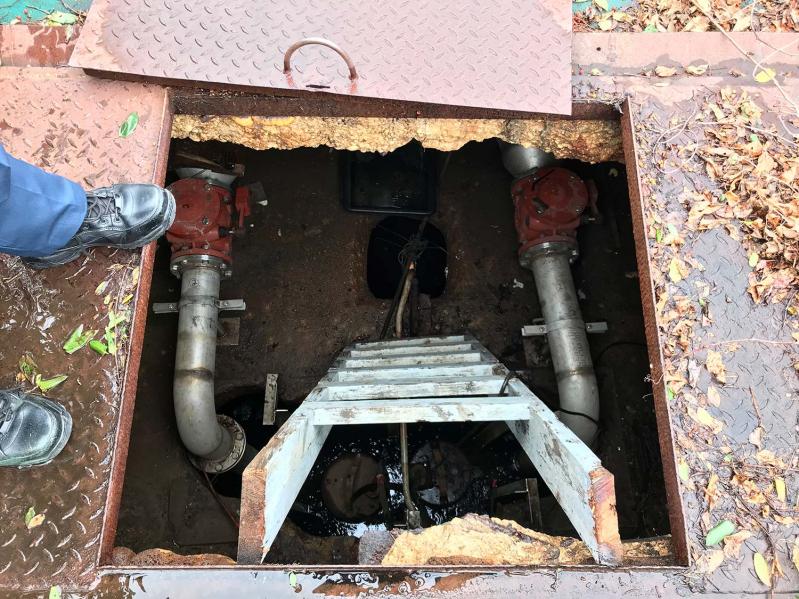“This is my pumping station,” said Dee Yardley, superintendent of public works for Sag Harbor Village. He was looking down at two large pumps buried near the Beacon restaurant on West Water Street. The entrance to the pumps is hidden, covered by brush and brambles. “I keep it camouflaged. There’s no reason for anyone to know they’re there except for me.”
After Superstorm Sandy, the pumps were the unsung heroes that removed an estimated eight million gallons of saltwater from the parking lot adjacent to where Adam Potter hopes to build a three-story, 74,980-square-foot mixed-use building with 39 apartments. The water had breached a bulkhead that extends along the shoreline between the Beacon and Baron’s Cove, passing through what are now Mr. Potter’s properties along Bridge and Rose Streets.
An Oct. 19 letter from David Bittner, an engineer for Bohler Engineering, which was submitted with Mr. Potter’s most recent proposal, said, “Once the application has progressed and the overall layout has been accepted, a full grading, drainage, and utility plan will be prepared.” In the meantime, he said, the engineers intended to prepare for a two-inch rain event and proposed 6,000 cubic feet of dry wells with leaching galleys, which would hold just under 45,000 gallons of water.
“Potter says he’s going to take care of our drainage problem. Okay, I’m going to be happy to see it,” Mr. Yardley said this week.
The only time the water has breached the bulkhead was during Superstorm Sandy. However, according to a report by the National Oceanic and Atmospheric Administration, titled “Projected Inundation Events and Sea Level Rise Scenarios,” using data from the Montauk buoy, while only four “high tide flooding” days are projected in 2023-24, 50 such days are projected in only 25 years. Should those days correspond with storm events, it’s reasonable to expect the bulkhead could be breached again, and perhaps more frequently.
The pumps are busy nonetheless, taking care of stormwater and a spring that has flowed for hundreds of years, and was a source of potable water for early villagers. It’s still there, behind the Sag Harbor Historical Society’s Annie Cooper Boyd house, corralled by Garden and Spring Streets, resting in one of only two remnants of what was once called the “great meadow.”
Mr. Yardley stared down as dark water rose around the pumps before their sunken machinery roared to life when a float crested a level. “So, there she goes,” he said with some pride, looking down at the quickly descending water. “If we walk over there, you’ll hear it gushing,” he said pointing at the cove. Staring down the side of the bulkhead facing the Beacon, water poured from a pipe. “That’s everything from the back of town.” And it’s all untreated.
“If the pumps stop, the water will quickly back up through the drains and flood that lot again. There’s no way for it to get out. It will be a pond again in six hours if the pumps go off,” he said, hinting at the other hidden thing under Sag Harbor’s backyard: a pond, George’s Pond, to be precise, at least that’s what it was called until 100 years ago, when it was still visible. “I don’t know where the name came from,” he said.
Mr. Yardley says it’s there still, under the parking lot next to Rose Street, just waiting to re-emerge.
Indeed, in maps from “Sag Harbor: An American Beauty” by Dorothy Ingersoll Zaykowski, written in 1997, the pond is clearly demarcated. Mr. Yardley paged through the book. It’s there in a hand-drawn map from the 1600s adjacent to the great meadow. It’s there in the 1700s, at the birth of Sag Harbor, when 34 building lots were sold along Main Street. Back then the village terminated not in Long Wharf, but in a 50-foot bluff, which was flattened. The sand from it was used to raise the length of Main Street at least five feet.
“Nothing was going on behind town in 1858,” said Mr. Yardley, “because it’s flooded.” By 1902, train tracks passed around the meadow, up Long Island Avenue, and terminated at Bay and Division Streets. The tracks were ripped up after the Hurricane of 1938. “Even in the 1940s they had cows roaming around back there, but it was just grass, no buildings, because it flooded all the time.” Only in the 1950s did the great meadow become dedicated to parking the newly ubiquitous automobile.
Prior to the 1980s there were no pumps. High tide came in, went as far as it did, back into the parking lots, and back out. “There was a beach along here,” said Mr. Yardley, looking down the length of the bulkhead by the Beacon. “That’s just the way it was. Back of town flooded.”
From the Water Street Shops building tracing a line along the back of Main Street to the Annie Cooper Boyd house, to Meadowlark, Howard and Garden Streets, and then down Long Island Avenue, all of that stormwater drains to the pumps. Three drains on Rose Street, which Mr. Potter specifically called out at a December village planning board meeting, are stained orange from standing water. They connect with a 24-inch pipe that runs parallel to Bridge Street, under the condominiums and Long Island Avenue, to the pumps.
“Fifteen acres of water, all coming to this pond. It wouldn’t take long to fill up,” said Mr. Yardley. “They’re going to have a fun time trying to engineer all of this out. Groundwater is a foot below the parking lot. Even a three-inch rain, which you had just a month and a half ago, overwhelmed the pumps. Rose Street was flooded. The back of town was blocked off. It took six hours to drain it.”

